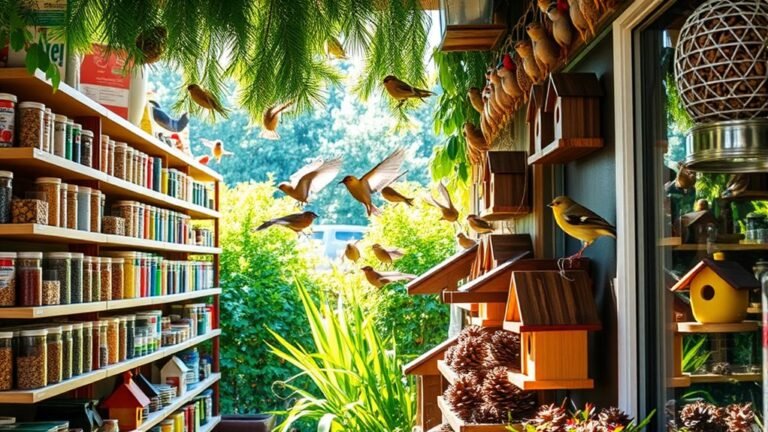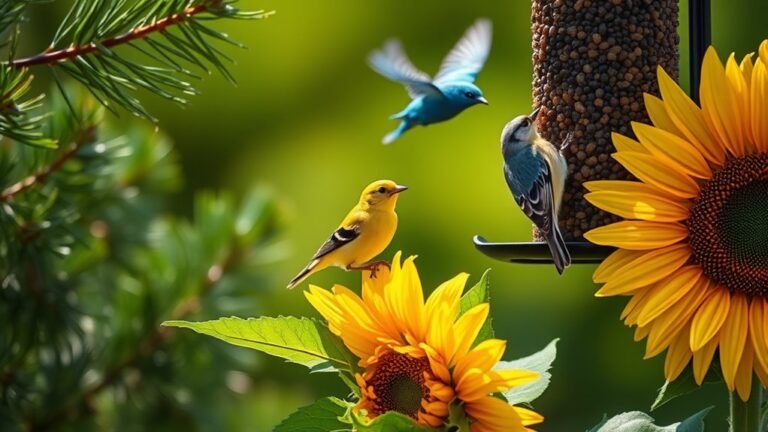Pennsylvania Backyard Bird Identification
Identifying backyard birds in Pennsylvania is a rewarding task. You can observe many different species, each with unique traits. Knowing the characteristics of common birds like Cardinals and Chickadees will improve your birdwatching.
Creating a welcoming environment in your backyard will help attract these birds. You can use feeders, birdbaths, and native plants to make your yard more inviting.
What steps can you take to make your backyard more appealing to birds?
Key Takeaways
- Use field guides like Peterson and Sibley to identify local bird species in Pennsylvania backyards.
- Observe bird behaviors, such as foraging and flocking, to aid in identification.
- Install bird feeders with sunflower and mixed seeds to attract various bird species.
- Document sightings to track personal progress and enhance identification skills.
- Join local birding clubs for shared knowledge and tips on backyard bird identification.
Understanding Pennsylvania's Birding Landscape
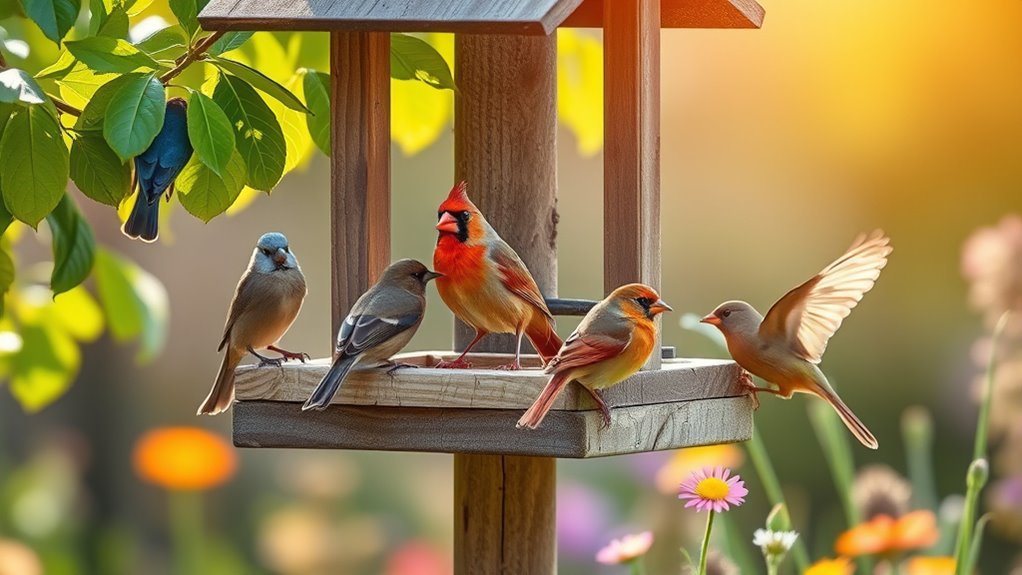
Pennsylvania has many different landscapes, including forests and fields. Each habitat supports various bird species.
The state features popular birding locations that attract both new and seasoned birders. Places like the PA Game Commission's preserves and the Delaware River are famous for seasonal bird migrations. In spring and fall, migratory birds gather in these areas, creating lively scenes.
Understanding these migration patterns can improve your birding experiences. By visiting these hotspots during migration seasons, you can connect with nature and meet other birders. This connection enhances your appreciation for Pennsylvania's bird diversity and builds a sense of community among birdwatching enthusiasts.
Common Backyard Birds of Pennsylvania
Pennsylvania has many great places to watch birds, but your backyard is also a fantastic spot. You can see birds like the American Robin, Northern Cardinal, and Tufted Titmouse visiting your feeders and trees.
Using binoculars can help you observe them closely, and keeping a birdwatching journal allows you to note their behaviors and interactions.
Be aware of seasonal changes, as different bird species migrate through Pennsylvania at various times of the year. This adds to the excitement of birdwatching.
Understanding how these birds behave enhances your outdoor experience and connects you to the local environment. So, get your binoculars and enjoy the birds right in your backyard!
The Majestic Bald Eagle: A Bird of Prey
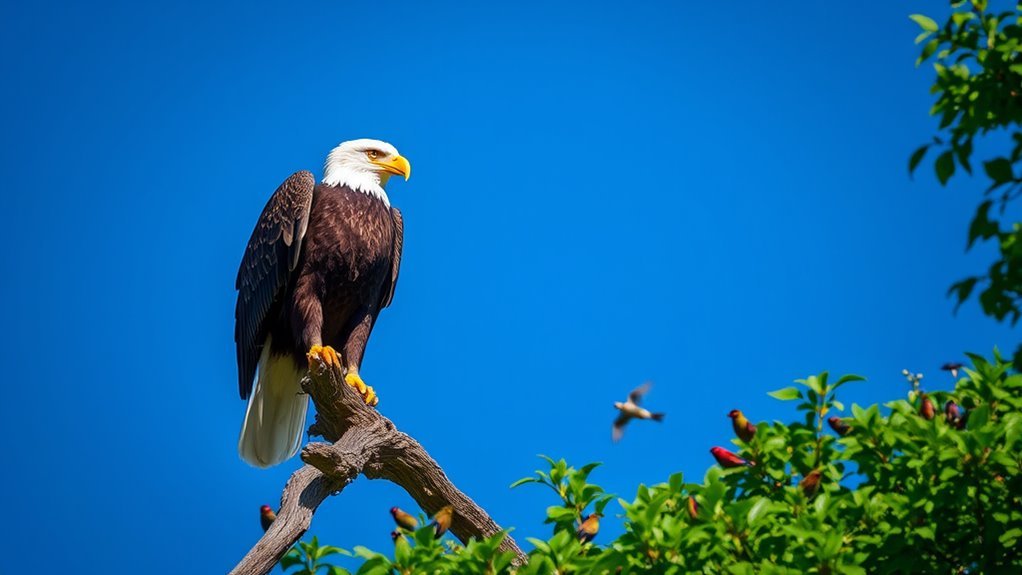
The Bald Eagle is a powerful symbol of strength and resilience in North America. You can often see them flying over large lakes, rivers, and coastal areas.
They've a large wingspan and sharp eyesight, making them skilled hunters, primarily of fish. However, Bald Eagles face threats from habitat loss and pollution.
Supporting conservation efforts is important to help these magnificent birds survive. You can assist by donating to local conservation groups or promoting clean water practices.
Creating a community that cares for these eagles not only helps protect a species but also strengthens our bond with nature.
Colorful Cardinals: The Scarlet Inhabitants
Colorful cardinals brighten up backyards with their vivid red feathers and distinctive black masks. These birds are social and often gather in flocks after the breeding season.
They form strong pair bonds, with both parents caring for their young. Male cardinals sing to defend territory or attract mates.
To welcome these attractive birds, place feeders with seeds and grow native plants. Enjoying cardinals in your yard connects you with nature and creates a sense of community.
The Charming Chickadee: Small, but Mighty
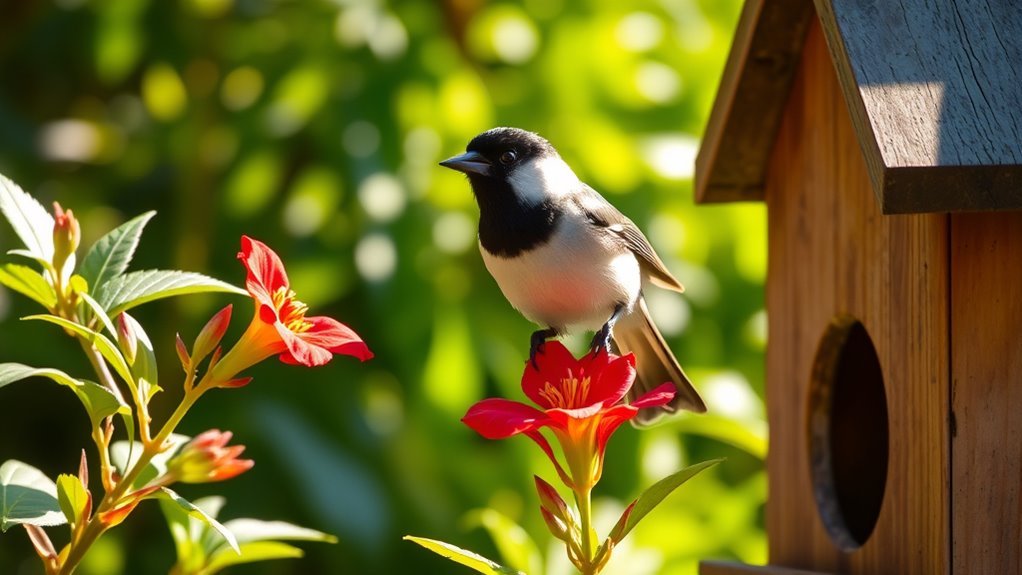
Chickadees are small birds that capture the attention of bird watchers. They've a playful nature and make loud, unique calls that sound like "chick-a-dee-dee-dee." These calls change based on the danger level from predators, showing how smart they're and how they communicate with each other.
For nesting, chickadees use tree holes or artificial boxes. A female typically lays between five and twelve eggs, displaying strong care for her young.
Watching chickadees can bring people together, as bird watchers enjoy their lively presence and the beauty of nature.
Nuthatches: Agile Acrobats of the Trees
Nuthatches are agile birds that climb tree trunks headfirst. They search for insects and seeds hidden in the bark. You can watch them as they extract food while hanging upside down.
Nuthatches build their nests in tree cavities, often using old woodpecker holes. They add materials like fur and moss to make a warm home for their young.
Observing nuthatches in your yard connects you to nature and enhances your birdwatching experience. Their lively behavior and adaptability make them a delight to spot in Pennsylvania's diverse birdlife.
Sparrows: The Subtle Beauties
Sparrows are small, adaptable birds commonly found in backyards. Some common species include the House Sparrow and the Chipping Sparrow. They come in various sizes and colors. You'll see them in gardens, estates, and farmland, often in areas with shrubs and low plants.
Sparrows thrive in places changed by humans. These birds are social and fun to watch. They often forage together in groups and chirp happily.
If you want to attract sparrows to your yard, provide natural cover and a supply of seeds. Knowing where they like to live can help you create a friendly environment for these delightful backyard companions.
The Graceful Goldfinch: Nature's Little Sunbeam
The Goldfinch is a small bird known for its bright yellow feathers and cheerful personality. Birdwatchers enjoy watching these birds due to their unique features.
They've streamlined bodies and produce lovely songs that bring energy to gardens. Their vibrant presence enhances the beauty of your yard and attracts other birds, creating a lively setting.
To attract Goldfinches, place feeders filled with thistle seeds in your garden. Watching them as they feed reveals their playful and acrobatic movements.
Whether you're a seasoned bird enthusiast or a beginner, inviting Goldfinches to your home connects you with a community of nature lovers who share a love for these charming birds.
Woodpeckers: Drummers of the Forest
Woodpeckers bring a unique energy to the trees in Pennsylvania. This state is home to several woodpecker species, including Downy, Hairy, and Red-bellied Woodpeckers. Each species has distinct markings and drumming sounds that create an exciting atmosphere in your backyard.
Woodpeckers make nests by creating holes in dead or dying trees. These holes serve as homes for their young and help maintain forest health by breaking down wood.
Watching these active birds provides insight into the ecosystem around you. You'll enjoy their rhythmic tapping and drumming, which reflect their resilience and creativity in nature.
Embrace the variety of woodpeckers and enrich your backyard experience.
Understanding Bird Behavior and Feeding Habits
Birds exhibit interesting behaviors and feeding habits that help them survive. Observing these traits can enhance your enjoyment of backyard birds. Here are some key points:
- Foraging strategies: Birds like chickadees search for seeds both on the ground and in trees. This flexibility helps them find food more easily.
- Social interactions: Many birds, such as blue jays, are social creatures. They form flocks, making it easier to find food through teamwork.
- Feeding techniques: Woodpeckers have unique ways of extracting insects from tree bark. These methods show how well they've adapted to their environment.
Understanding these behaviors can deepen your appreciation for the birds you see in your backyard. Enjoy watching how they interact with their surroundings!
Tips for Attracting Birds to Your Backyard
Attracting birds to your backyard can be enjoyable and educational. To invite a variety of birds, start by placing bird feeders with seeds suited for your local species, such as sunflower seeds and mixed blends.
Hang these feeders at different heights to meet the feeding needs of different birds.
In addition to feeders, plant native plants in your yard. Native plants offer food and shelter for birds, creating a welcoming habitat.
Include flowering plants that produce seeds and shrubs that bear berries.
Resources for Birdwatching in Pennsylvania
To improve your birdwatching experience in Pennsylvania, several helpful resources are available.
Consider these three important tools:
- Birdwatching Apps: Use simple apps like Merlin Bird ID or eBird. These tools help you identify birds and keep track of your sightings easily.
- Field Guides: Get field guides that focus on birds in Pennsylvania. Books by Peterson or Sibley provide clear information to help you identify different species.
- Local Birding Clubs: Join a local birding club. This will connect you with experienced birdwatchers who can share useful tips and insights.
These resources can enhance your birdwatching journey in Pennsylvania, making it enjoyable and fulfilling.
Frequently Asked Questions
What Time of Year Is Best for Birdwatching in Pennsylvania?
The best time for birdwatching in Pennsylvania is during spring migration. You will see many birds returning and displaying vibrant activity. Winter also offers birdwatching opportunities, but you will see fewer species. Each season provides unique experiences, deepening your connection to nature. Enjoy observing the changes as birds come and go throughout the year.
How Can I Identify Bird Calls and Songs?
To identify bird calls and songs, listen carefully and take notes. Use apps that recognize bird sounds. Learn about common bird species in your area. Understanding their voices will improve your birdwatching experience and help you connect with others who share this interest.
Are There Any Rare Birds in Pennsylvania I Should Look For?
To spot rare birds in Pennsylvania, look during peak migration seasons. Watch for unique species like the Prothonotary Warbler and the Scarlet Tanager. These sightings can make your birdwatching more enjoyable and connect you with fellow bird enthusiasts.
What Types of Feeders Attract Specific Bird Species?
To attract specific bird species, select the right types of seeds. Use sunflower seeds to attract finches and peanuts for woodpeckers. Place feeders near trees or bushes to provide cover for birds. This setup makes it easier for birds to feed while keeping them safe from predators. By doing this, you can create an inviting space for birds in your backyard, making birdwatching enjoyable.
How Can I Create a Bird-Friendly Garden?
To create a bird-friendly garden, use native plants that offer food and shelter. Add birdbaths or other water sources to help birds stay hydrated. These simple steps will attract various bird species and create a welcoming space for them. Enjoy watching the birds and appreciate their beauty in your garden.

Hello, I’m Amelia White, the founder of birdsfanatic.com. As a lifelong bird enthusiast and spiritual seeker, I’ve always been fascinated by the mystical connections between birds and the human experience. On this site, I share my knowledge and insights into the symbolic meanings and spiritual significance of various bird species, exploring their roles in mythology, folklore, and cultural traditions. Join me on this journey into the world of birds, where we’ll discover the hidden wisdom and guidance that these magnificent creatures have to offer.


